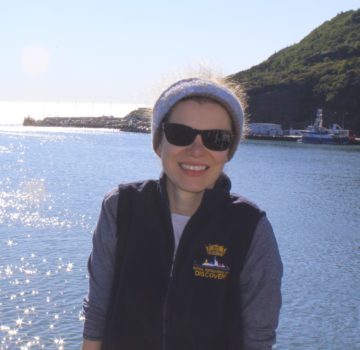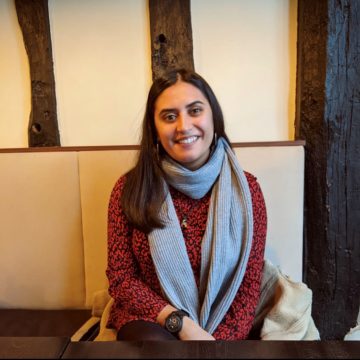3 December, 2021 Diversity in UK Polar Science
Today, 3 December 2021, is the United Nations International Day of Persons with Disabilities (IDPD). The theme this year focuses on “Leadership and participation of persons with disabilities toward an inclusive, accessible and sustainable post-COVID-19 world.” In this guest blog, Dr Kate Hendry (she/her), Associate Professor of Geochemistry in the University of Bristol School of Earth Sciences, and Rad Sharma (she/her) Mechanical Engineer at British Antarctic Survey share their motivations and experiences learning British Sign Language (BSL). This blog is part of a series of activities for the Diversity in UK Polar Science Initiative.

Dr Kate Hendry, Associate Professor of Geochemistry, University of Bristol
My story
I’ve been interested in BSL as a Deaf ally for a few years now. I started to learn a while ago, driven by finding out about the barriers that Deaf colleagues have in working in ocean sciences. It also occurred to me that there could be barriers for Deaf people relating to science education and outreach opportunities, if there isn’t a BSL interpreter available. I wanted to do my bit to break down some of these barriers and improve accessibility.
However, once I started to learn, I found the language so fascinating (and beautiful) that I wanted to carry on! I got my Level 2 BSL qualification from the City of Bristol College back in 2018, and am hoping to carry on to Level 3 if possible.
How is BSL different from hearing/spoken language?
BSL is structured in a very different way to English: the syntax is very different. For example, questions are ordered in a different way. To sign “What is your name?”, you use the signs for “name”, “you”, and “what?”, in that order.
Signing can feel more like painting a picture than structuring a sentence, especially when describing a person or a place.
Sometimes, BSL signs translate as a single word. These can be very literal (in the case of “book”), somewhat related or associated (in the case of “dog”) or can be quite abstract (in the case of “sport”).
Other times, signs can portray quite complex meanings that can’t be translated to a single word (for example, there’s a sign that means something like “it’s been such a long time since I’ve seen you!”).
There are a few aspects of signs that have recurrent meanings. For example, the thumb is often associated with “good” (featuring in the words “nice” and “favourite”, for example), whereas the little finger is often associated with “bad” (and features in the words for “sour” or “bully”, for example).
Signing requires the use of more than your hands. Lip movements are critical, as are facial expressions. There’s a lot to do with space as well, and where (and how quickly) you sign in relation to your body (representing time or distance, for example).
There are lots of different versions of sign language in different countries (so, BSL is very different from American Sign Language, ASL). There are even variations within a country, with subtle (or not so subtle) differences in signs from region-to-region.
Putting it into practice
I’ve now done some outreach activities, including a visit to a local school for Deaf and hard of hearing students to teach about polar research. Fortunately the students were having so much fun with the Antarctic kit-bag clothing that they didn’t seem to mind my amateur signing (and I also had an interpreter there to help me as well)!

Rad Sharma, Mechanical Engineer, British Antarctic Survey (BAS)
My Story
Sign language is something I’ve always been interested in learning, so I jumped at the chance to do my Level 1 whilst at sixth form. I wanted to pursue it further but struggled to find time to attend a course, until during the pandemic when I discovered the option to have virtual one to one lessons! The EDI team at BAS have very kindly supported me in doing this.
I learned face-to-face with a hearing teacher initially, which was a bit easier! My Level 2 is happening with a deaf tutor over Zoom.
How is BSL different from hearing/spoken language?
Having “British” in the name can make people think that it’s a visual translation of English, which isn’t the case. Like other foreign languages, it has different sentence structures, words and phrases and dialects/accents. I think that the difference in specific words/phrases is something people understand more easily with foreign spoken languages, but their expectations for BSL are often that everything will be an exact translation of the spoken English equivalent.
Putting it into practice
I haven’t had much opportunity to use BSL yet, so most of my practice comes from YouTube. I did have a pleasant experience with a colleague on my team who turned out to be fluent in BSL and we exchange little greetings – he learned the sign for “happy Diwali” for example, which was lovely! It does make me wonder how many people I know who might have a knowledge of BSL that I am unaware of, and vice versa.
Sign language is something I’m quite surprised isn’t part of the mainstream curriculum. Even just learning basic phrases and finger spelling would make a world of difference to someone who needed to communicate something. It doesn’t take very long to get a Level 1 qualification, so I think it’s quite an easy thing for organisations to provide access to in order to make their workplaces drastically more inclusive to someone who is hearing impaired. Especially now with masks being prominent, when a lot of deaf people would use lip reading to understand someone else. I’m lucky that my organisation has been so enthusiastic in supporting my learning!
Find out more about the Diversity in UK Polar Science Initiative.
